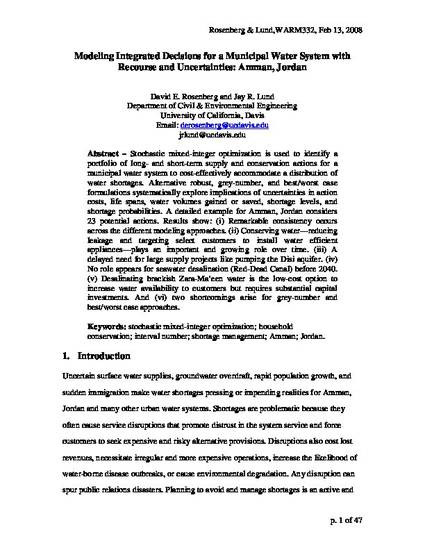
Article
Modeling Integrated Decisions for a Municipal Water system with Recourse and Uncertainties: Amman, Jordan
Water Resources Management
Document Type
Article
Publisher
Springer Verlag
Publication Date
1-1-2009
Disciplines
Abstract
Stochastic mixed-integer optimization is used to identify a portfolio of long- and short-term supply and conservation actions for a municipal water system to cost-effectively accommodate a distribution of water shortages. Alternative robust, grey-number, and best/worst case formulations systematically explore implications of uncertainties in action costs, life spans, water volumes gained or saved, shortage levels, and shortage probabilities. A detailed example for Amman, Jordan considers 23 potential actions. Results show: (1) remarkable consistency occurs across the different modeling approaches. (2) Conserving water—reducing leakage and targeting select customers to install water efficient appliances—plays an important and growing role over time. (3) A delayed need for large supply projects like pumping the Disi aquifer. (4) No role appears for seawater desalination (Red–Dead Canal) before 2040. (5) Desalinating brackish Zara-Ma’een water is the low-cost option to increase water availability to customers but requires substantial capital investments. And (6) two shortcomings arise for grey-number and best/worst case approaches.
Citation Information
David Rosenberg and Jay Lund (2009). “Modeling Integrated Water Utility Decisions with Recourse and Uncertainty: Amman, Jordan.” Water Resources Management, 23 (1), doi 10.1007/s11269-008-9266-4, pp. 85-115.

Note: David Rosenberg was affiliated with the University of California - Davis at time of publication.